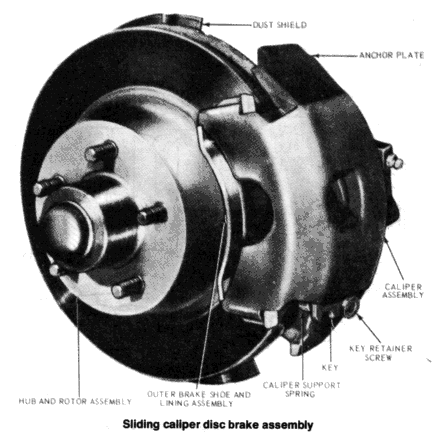Maverick and Comet Repair
Maverick and Comet Brakes
BRAKES - DISC BRAKES
Instead of the traditional expanding brakes that press outward against a circular drum, disc brake systems utilize a cast iron disc with brake pads (linings or shoes). Braking effect is achieved in a manner similar to the way that you would squeeze a spinning phonograph record between your fingers. The disc (rotor) is a one-piece casting with cooling fins between the two braking surfaces. This enables air to circulate between the braking surfaces, making them less sensitive to heat buildup and more resistant to fade. Dirt and water do not affect braking action since such contaminants are thrown off by the centrifugal action of the rotor or scraped off by the pads. Also, the equal clamping action of the brake pads tends to ensure uniform, straight line stops. All disc brakes are inherently self-adjusting.
Sliding caliper disc brakes are used at the front of many 1974 and later models. The name of this system is derived from the slide action of the brake caliper on the anchor plate during braking. The plate-like brake rotor is attached to and mounted on the car by the front wheel hub. A brake caliper anchor plate, attached to the front wheel spindle, mounts over the top of, but does not touch, the rotor. The caliper is mounted in the middle of the large opening in the anchor plate. When the brake pedal is depressed, and hydraulic force is generated, the piston in the caliper forces the inboard brake pad inward and into contact with the brake rotor. The caliper now begins to act like a C-clamp, with the inboard shoe and the piston acting as the adjustable screw. Since there is only a small amount of clearance between the brake pads and the rotor, the inboard shoe contacts the rotor almost as soon as the brake pedal is depressed. As the brake pedal is depressed further, it increases the amount of hydraulic pressure sent to the piston in the caliper. Since the inboard shoe is already in contact with the brake rotor, it cannot be moved. As the caliper pushes on the inboard brake shoe, the increased hydraulic pressure forces the back of the caliper housing away from the back of the piston. This causes the caliper to slide inward on the anchor plate and force the outboard brake pad into contact with the rotor. Thus the name sliding caliper. This happens very quickly, so both pads contact the rotor at about the same time.

Return to Brakes - Removal, Repacking & Installation Disc Brakes